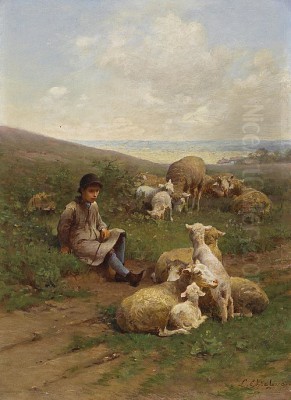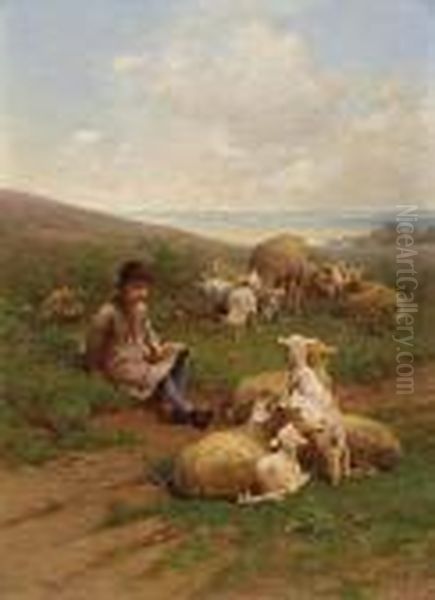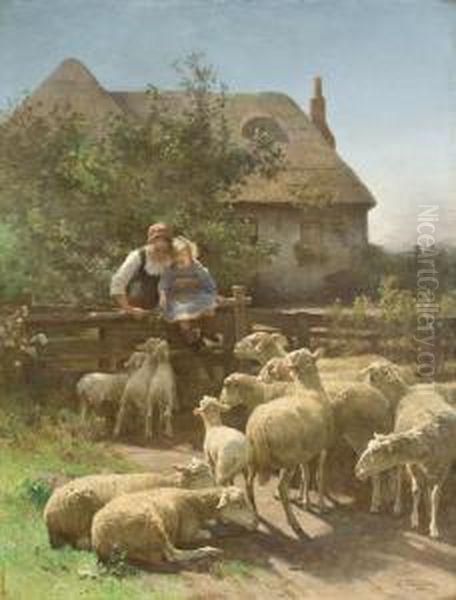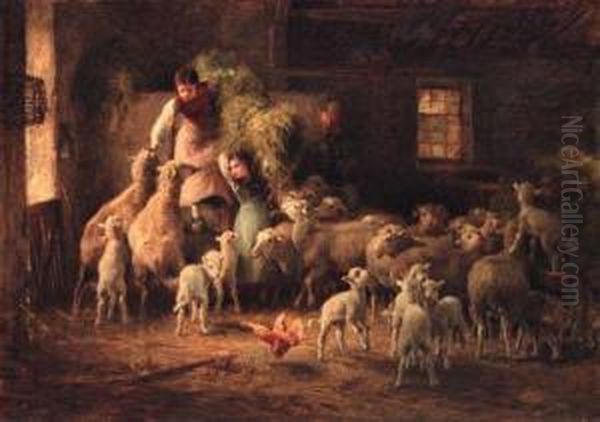
Luigi Chialiva stands as a significant, albeit sometimes overlooked, figure in the landscape of late 19th and early 20th-century European art. Born in Switzerland but of Italian nationality, Chialiva carved a distinct niche for himself through his sensitive and highly skilled depictions of pastoral scenes, particularly those involving animals. His work bridges the artistic currents of Italy, Switzerland, and France, reflecting the pervasive influence of Realism while retaining a unique, gentle quality often associated with the Écouen school. His technical proficiency and connections with major artists like Edgar Degas further solidify his place in art history.
A Swiss Birth, An Italian Identity
Luigi Chialiva entered the world on July 16, 1841, in Caslano, near Lugano, within the Italian-speaking region of Switzerland. His background was notable; his father, Abbondio Chialiva, was a respected Swiss politician and patriot involved in the movements for Italian unification. His mother, Maria Medina, hailed from an Italian family. This dual heritage perhaps informed the artist's later movements and affiliations, comfortably navigating both Swiss and Italian cultural spheres, though he is primarily identified as an Italian painter by nationality.
His early education was not initially directed towards the arts. Chialiva attended the prestigious Zurich Polytechnic Institute, where his studies focused on architecture and even chemistry. This scientific and structural grounding may have subtly influenced his later artistic approach, perhaps contributing to the careful composition and technical experimentation evident in his work. However, the pull towards fine arts proved stronger, leading him to pursue formal training.
Artistic Formation Across Europe
Chialiva's journey into professional painting involved studies in key artistic centers. He honed his skills at the Brera Academy (Accademia di Belle Arti di Brera) in Milan, a major institution in Lombardy. Sources suggest he may have studied or been associated with the circle of Antonio Fontanesi, a prominent landscape painter whose work emphasized light and atmosphere, potentially influencing Chialiva's own sensitivity to natural effects.

His training continued in Rome, where he focused on mastering the depiction of the human form through life drawing. It was during his time in Italy, likely in Rome or Florence, that he forged connections that would prove significant later in his career. The artistic environment of Italy, with its rich history and burgeoning realist tendencies, undoubtedly shaped his developing aesthetic.
Further enriching his artistic perspective, Chialiva spent considerable time in France. He became closely associated with the Écouen art colony, located just north of Paris. This association was pivotal, placing him under the influence of Pierre Édouard Frère, a leading figure of the school known for his gentle, empathetic portrayals of rural life and childhood.
The Écouen School and Sympathetic Realism
The Écouen colony was a significant hub for artists drawn to Realism but often imbued with a sentimental or narrative quality, sometimes termed "Sympathetic Art." Unlike the harsher social realism found in the work of artists like Gustave Courbet, the Écouen painters, including Chialiva, focused on the quiet dignity and everyday moments of peasant life, often featuring children and animals. The emphasis was on careful observation, detailed rendering, and evoking a sense of warmth and connection with the subjects.
Chialiva became a key member of this artistic community. His style aligned well with the Écouen ethos, blending meticulous realism with a gentle, almost idyllic portrayal of the countryside. He worked alongside other notable artists associated with the colony, such as August Schenck, also known for his animal paintings (especially sheep in snow), Théophile Emmanuel Duverger, who specialized in genre scenes often involving children and clergy, and Paul Charles Saignac (often confused with Paul Seignac), who also painted genre scenes. This environment fostered a shared interest in rural themes and precise technique.
A Specialist in Animal Painting
While adept at landscape and genre scenes, Luigi Chialiva gained particular renown for his depictions of animals, especially sheep. He possessed an exceptional ability to capture the textures of fleece, the characteristic postures of the animals, and their integration within the landscape. His sheep are not mere pastoral accessories but carefully observed subjects, rendered with both accuracy and affection.

Anecdotes surrounding his working methods highlight his dedication to animal subjects. It is reported that his studio in Écouen had a unique feature: a section was partitioned off with glass, allowing him to observe animals – sheep, poultry, perhaps even cattle – directly from his workspace in various natural lighting conditions. This setup enabled him to achieve a high degree of realism based on direct study. His wife, an American named Julia, is said to have assisted him in managing these animal models, ensuring they were calm and well-cared for, facilitating the artist's work.
This focus on direct observation aligns perfectly with the tenets of Realism, which emphasized truthfulness to nature over idealized or academic conventions. Chialiva's commitment to studying his animal subjects closely contributed significantly to the convincing quality and enduring appeal of his paintings.
Representative Works: Capturing Pastoral Harmony
Several paintings exemplify Chialiva's style and preferred themes. Works like Young Shepherd and Feeding The Sheep showcase his mastery in depicting sheep and their interaction with human figures, typically young peasants. These scenes are often set in tranquil landscapes under soft, diffused light, emphasizing a harmonious relationship between humans, animals, and nature.
Feeding Time is another characteristic work, often depicting girls or women tending to flocks of sheep or poultry. These paintings highlight Chialiva's skill in composing multi-figure scenes and capturing the textures of clothing, foliage, and animal coats with equal finesse. The mood is typically peaceful and industrious, celebrating the simple rhythms of rural existence.
A title sometimes cited is Shepherd with Choir (perhaps more accurately translated as Shepherd and Flock or similar, as "Choir" seems unusual in this context). Regardless of the precise title, such works underscore his recurring interest in the pastoral theme, a subject popular throughout the 19th century but treated by Chialiva with particular sensitivity and observational skill. His works found favour with collectors and institutions, reflecting their appeal.
The Connection with Edgar Degas
One of the most fascinating aspects of Chialiva's career is his well-documented friendship and technical exchange with the Impressionist master Edgar Degas. The two artists likely met either during Chialiva's time in Italy or later in Paris, where Chialiva established himself. Degas, known for his demanding standards and sharp intellect, held Chialiva's technical abilities in high regard.

A key anecdote involves a special fixative for pastel. Chialiva, drawing perhaps on his early chemical studies or studio experimentation, developed or possessed a recipe for a fixative that could stabilize pastel drawings without significantly altering the colours or the surface texture – a major challenge for pastel artists. He shared this formula with Degas, who was increasingly working in pastel and found the fixative immensely useful. This technical contribution directly impacted the working methods of one of history's most innovative artists.
Furthermore, Chialiva is credited with introducing or popularizing a technique involving tracing paper (papier calque) for transferring or correcting drawings. Degas also adopted this method, which allowed for compositional adjustments and the creation of series based on repeated figures. This exchange demonstrates that influence flowed in multiple directions within the artistic circles of the time, even between artists associated with different movements like Realism and Impressionism. Degas reportedly owned at least one painting by Chialiva, further testament to his respect.
Chialiva's Parisian connections extended beyond Degas. He was acquainted with other prominent figures, including the elegant society painter James Tissot (Jacques-Joseph Tissot) and the painter and printmaker Pierre-Georges Jeanniot. He was also part of the circle that included expatriate Italian artists in Paris, such as the highly successful Giuseppe De Nittis, known for his vibrant cityscapes and society scenes. Another Italian artist mentioned in connection with Chialiva is Giacomo Carone, though less is widely known about him. These connections place Chialiva firmly within the dynamic artistic milieu of Paris in the latter 19th century.
Technical Innovations and Craftsmanship
Beyond his specific interactions with Degas, Chialiva's interest in the technical aspects of painting was evident. His development of the fixative and his use of tracing paper underscore a practical, craftsman-like approach to his art. This focus on materials and methods was characteristic of many 19th-century artists who sought greater control over their medium to achieve specific expressive effects.
His meticulous technique, characterized by fine brushwork and careful attention to detail, especially in rendering textures like wool, feathers, and foliage, speaks to a high level of technical discipline. While not radically innovative in the manner of the Impressionists' broken brushwork, Chialiva's technique was perfectly suited to his realist aims, allowing him to create convincing and visually pleasing representations of the natural world.
International Recognition and Later Life
Chialiva's talent did not go unnoticed during his lifetime. As early as 1868, he received significant recognition when he was awarded the first prize for animal painting by the prestigious Mylins Foundation in Milan. This award acknowledged his exceptional skill in a genre for which he would become best known.
His reputation extended internationally. His paintings were acquired by museums in various European cities, including the Musée National d'Histoire et d'Art in Luxembourg, the Galleria Nazionale d'Arte Moderna in Rome, and galleries in Milan and Sheffield, UK. This geographical spread indicates a broad appreciation for his work across different countries.
Adding another international dimension to his life, Chialiva spent time in the United States and married an American woman, Julia Adelaide Jay. While details of his time in America are less documented than his European career, this connection further illustrates the transatlantic networks developing in the art world during this period. He eventually returned to France, where he spent his later years. Luigi Chialiva passed away in Paris in 1914, leaving behind a substantial body of work.
Legacy and Art Historical Position
In the grand narrative of art history, Luigi Chialiva occupies a position as a highly accomplished practitioner of late 19th-century Realism, with a particular specialization that brought him considerable acclaim. While perhaps not as revolutionary as contemporaries like Claude Monet or his friend Edgar Degas, Chialiva excelled within his chosen field. He represents the enduring appeal of pastoral themes and the high level of technical skill valued in academic and realist circles.
His association with the Écouen school places him within a specific movement that championed empathetic portrayals of rural life, offering a gentler counterpoint to some of the era's more overtly political or starkly realist art. His mastery of animal painting, especially sheep, remains a defining feature of his oeuvre, admired for its observational accuracy and sensitive rendering.
Furthermore, his documented technical exchanges with Edgar Degas give him a unique footnote in the history of Impressionism, demonstrating his practical knowledge and his respected position among fellow artists. He serves as an important link between Italian artistic traditions, the Swiss context of his birth, and the dominant French art scene centered around Paris and its associated artist colonies like Écouen. Luigi Chialiva's legacy resides in his beautifully crafted paintings that continue to charm viewers with their peaceful depictions of rural harmony and his remarkable skill in bringing animals to life on canvas.